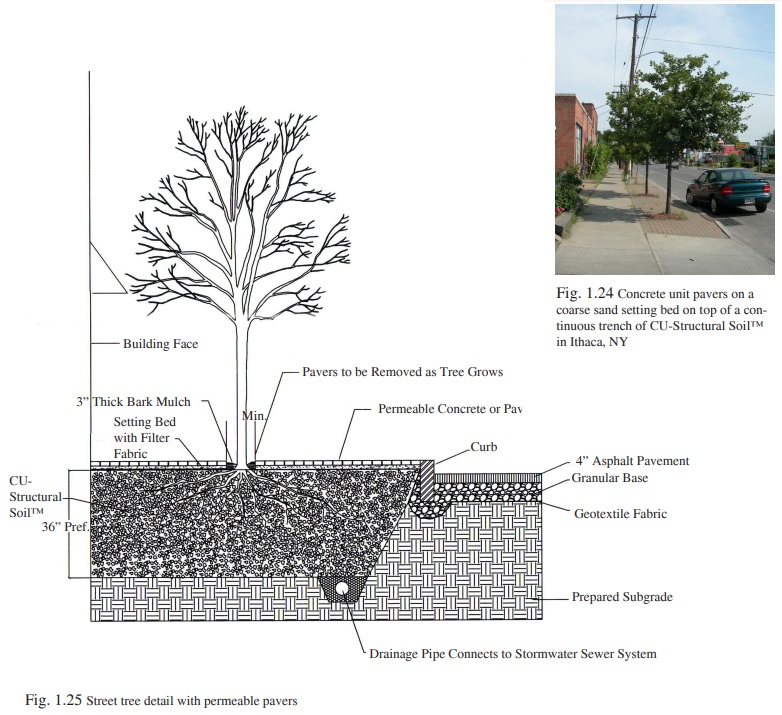The Case for CU-Structural Soil™: Why do we need it, what is it, and how is it used? Dr Nina Bassuk of the School of Integrative Plant Science explains
Urban trees experience a litany of environmental insults: soil and air pollution, heat loads, deicing salts, and impacts from utilities, vehicles, and buildings. The most significant problem that urban trees face, however, is the lack of usable soil volume for root growth, since trees are often an afterthought in city planning and streetscape design. (Fig. 1.1)
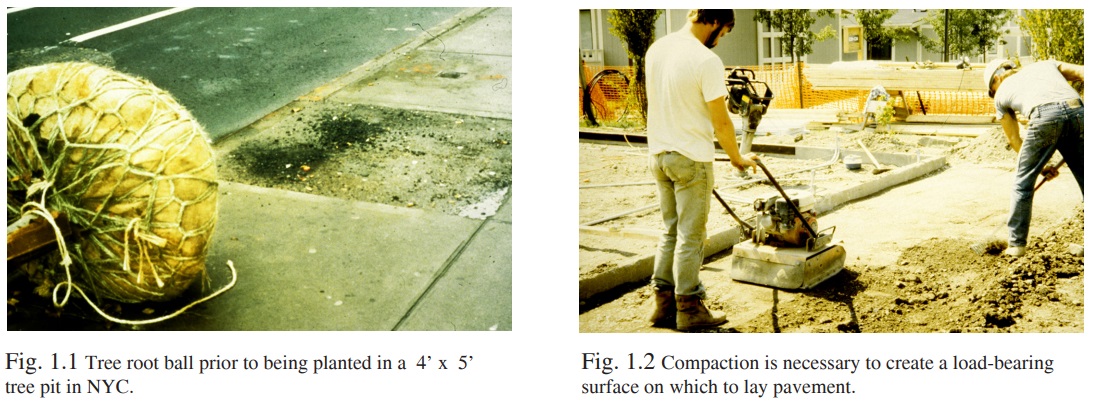
Soil Compaction
Ongoing construction, including sidewalk and road repair, disturbs and compacts soil (Fig. 1.2), crushing macropores (Fig. 1.3). Loss of macropores has three negative consequences: restricted aeration, diminished water drainage, and creating a dense soil that is difficult for roots to penetrate. These effects limit usable rooting space.
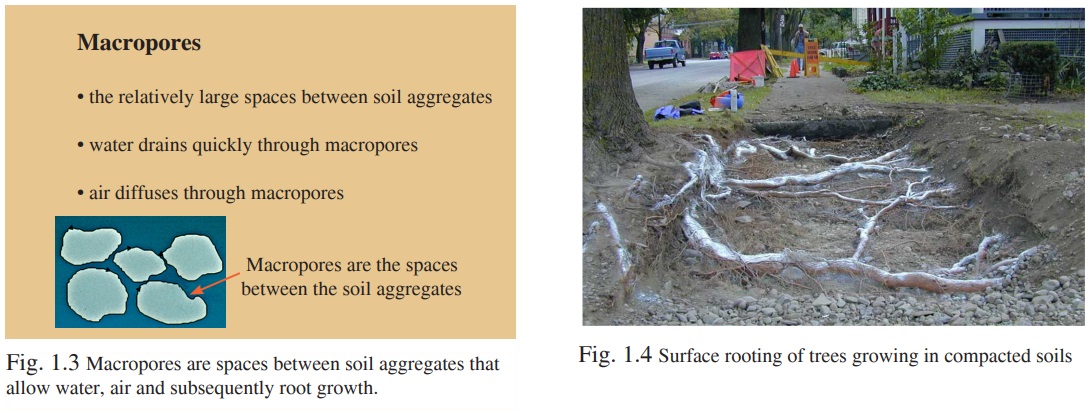
What happens when roots encounter dense, compacted soil?
When roots encounter dense soil, they change direction, stop growing, (Fig 1.5) or adapt by remaining abnormally close to the surface (Fig. 1.4) This superficial rooting makes urban trees more vulnerable to drought and can cause pavement heaving. However, if a dense soil is waterlogged, tree roots can also rot from lack of oxygen.
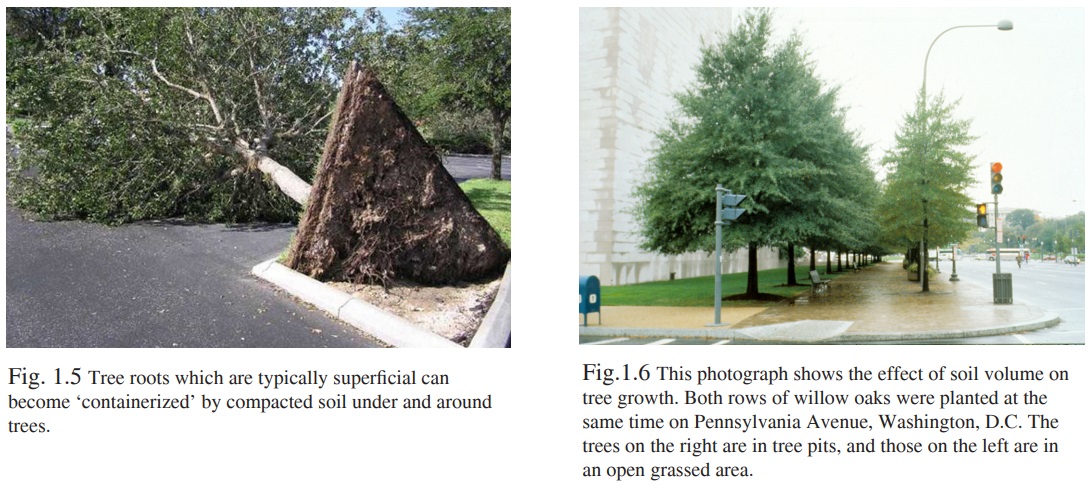
The role of soil volume on tree growth
The soil in urban tree lawns or parks can be improved by amendment or soil replacement. Where soil volume is limited by pavement, tree roots suffer (Fig 1.6). The highly compacted soils required for constructing pavements do not allow root penetration, resulting in declining trees which are all too common in cities. Yet it is precisely these paved areas such as parking lots and streets that most need the mitigating effects of shade trees.
Healthy trees need a large volume of non-compacted soil with adequate drainage and aeration and reasonable fertility. CU-Structural Soil™ meets these needs while also fulfilling engineers’ load-bearing requirements for base courses under pavement.
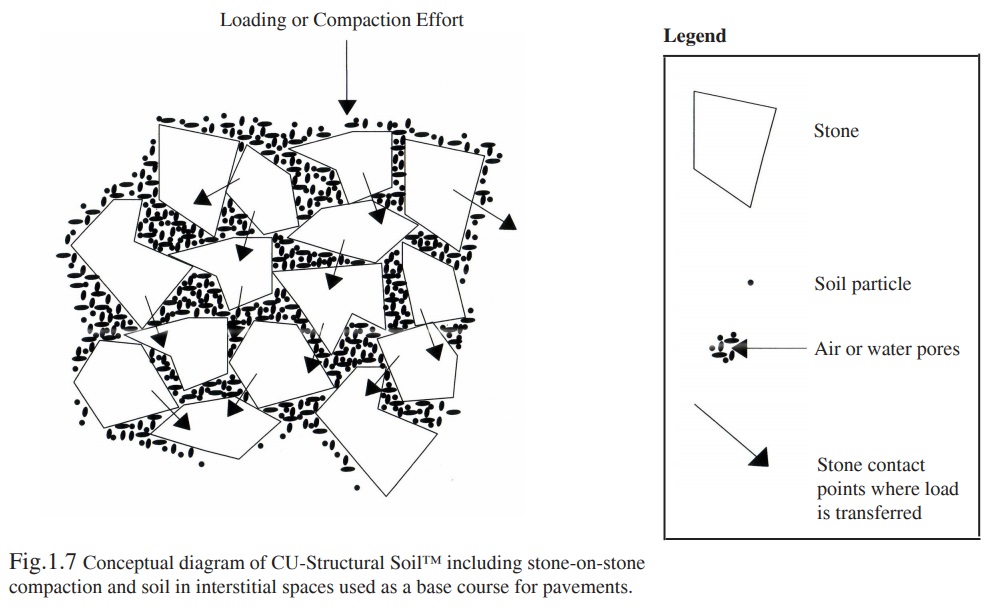
CU-Structural Soil™ Basics
CU-Structural Soil™ (U.S. Patent # 5,849,069) is a two-part system comprised of a rigid stone “lattice” to meet engineering requirements for a load-bearing soil, and a quantity of soil, to meet tree requirements for root growth. The lattice of load-bearing stones provides stability as well as interconnected voids for root penetration, air and water movement (Fig. 1.7). The uniformly graded 3/4”-1 1/2” angular crushed stone specified for CU-Structural Soil™ is designed to ensure the greatest porosity. Crushed or angular stone provides more compaction and structural interface of stone-to-stone than round stone. Because stone is the load-bearing component of structural soil, the aggregates used should meet regional or state department of transportation standards for pavement base courses.
Since among soil textures, clay has the most water and nutrient-holding capacity, a heavy clay loam or loam, with a minimum of 20% clay, is selected for the CU-Structural Soil™ system. CU-Structural Soil™ should also have organic matter content ranging from 2%-5% to ensure nutrient and water holding while encouraging beneficial microbial activity. A minimum of 20% clay is also essential for an adequate cation exchange capacity.
With carefully chosen uniformly-graded stone and the proper stone to soil ratio, a medium for healthy root growth is created that also can be compacted to meet engineers’ load-bearing specifications (Fig. 1.8). The intention is to “suspend” the clay soil between the stones without over-filling the voids, which would compromise aeration and bearing capacity. CU-Structural Soil™ utilizes Gelscape® hydrogel as a non-toxic, non-phytotoxic tackifier, in addition to stone and soil components.
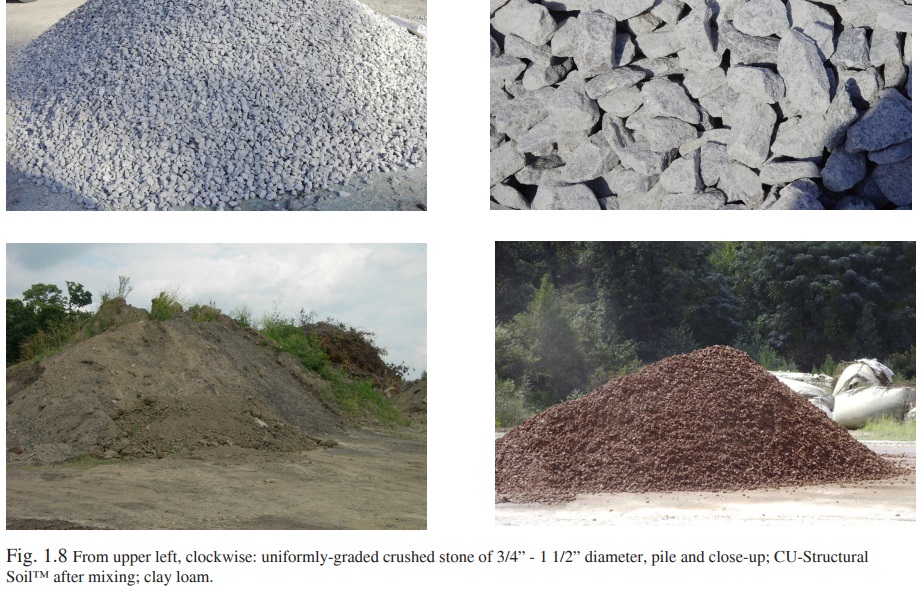
Using CU-Structural Soil™ for Street Trees
CU-Structural Soil™ is intended for paved sites to provide adequate soil volumes for tree roots under pavements (Fig. 1.9). It can and should be used under pedestrian mall paving, sidewalks, parking lots, and low-use access roads. The Urban Horticulture Institute is currently conducting trials of its use under turf and porous asphalt to provide more porous parking areas. Research at Cornell has shown that tree roots in CU-Structural Soil™ profiles grow deep into the base course material, away from the fluctuating temperatures at the pavement surface. One benefit of this is that roots are less likely to heave and crack pavement than with conventional paving systems (Fig. 1.10).
Planting a tree into CU-Structural Soil™ is much like conventional planting. If possible, the pavement opening should be expandable (via removable pavers or using a mulched area) for the sake of the anticipated buttress roots of maturing trees (Fig. 1.11). CU-Structural Soil™ should be used at a depth of at least 24” but preferably 36” (Fig.1.12). CU-Structural Soil™ can be used right up to the surface grade where there is a pavement opening that is large enough to allow for tree installation.
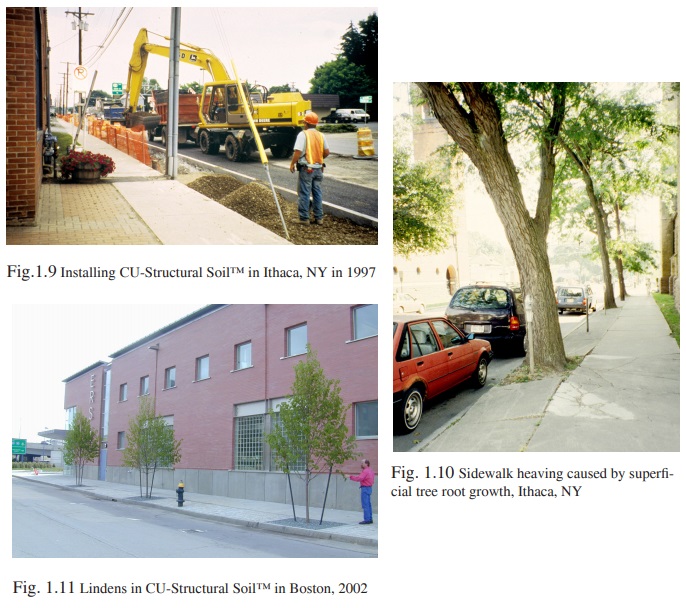
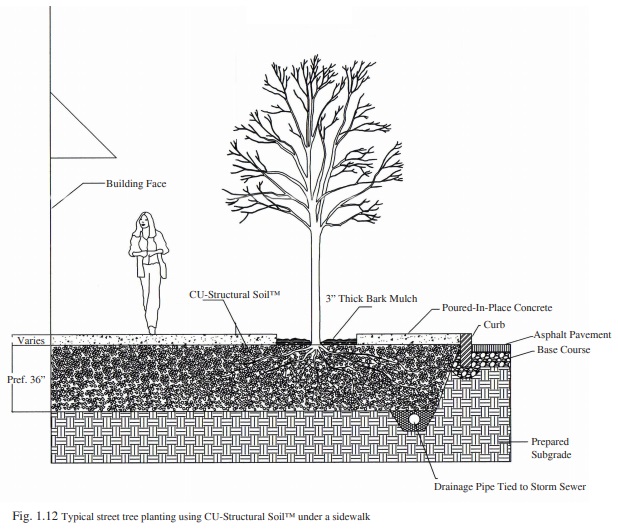
Trees in Parking Lots and Plazas
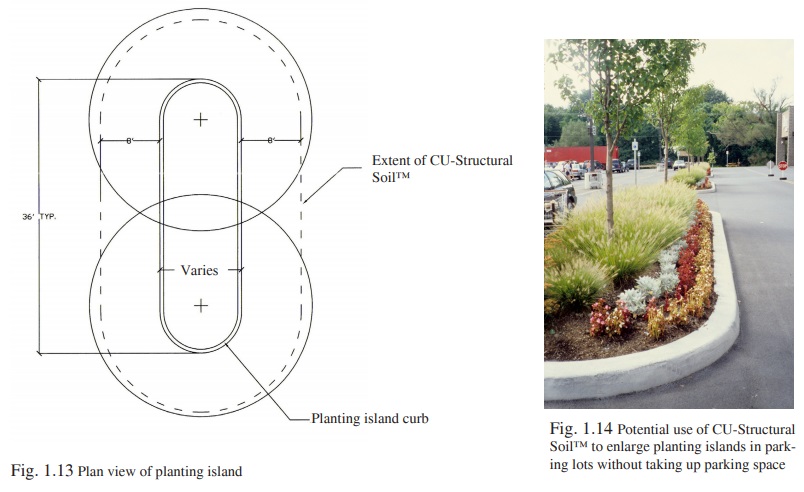
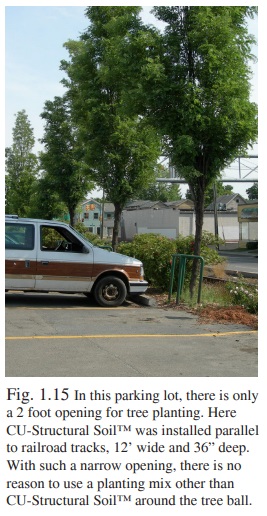 CU-Structural Soil™ may also be used to enlarge a ‘tree island’ within a parking lot. With a large tree planting area, good, well draining topsoil can be used in the island and CU-Structural Soil™ added as an unseen rooting medium under the asphalt (Figs. 1.13 – 1.15).
CU-Structural Soil™ may also be used to enlarge a ‘tree island’ within a parking lot. With a large tree planting area, good, well draining topsoil can be used in the island and CU-Structural Soil™ added as an unseen rooting medium under the asphalt (Figs. 1.13 – 1.15).
Trees in parking lots, as well as paved plazas, benefit from the use of CU-Structural Soil™ (Fig.1.16 – 1.17). Whether there is a curb or not, good, well-drained topsoil may be used around the tree where the opening is at least 5’ x 5’. If the opening is smaller, CU-Structural Soil™ may be used right up to the tree ball. Although it is not necessary to use
an additional base course on top of CU-Structural Soil™, some engineers may want to do this, immediately under the pavement.
Given the large volume of CU-Structural Soil™ for tree roots to explore, irrigation may not be necessary after tree establishment—the decision depends on the region of the country and on site management. While there is less moisture in CU-Structural Soil™ on a per-volume basis than in conventional soil, the root system in structural soil has more room for expansion, allowing for increased water absorption. Supplemental water should be provided during the first growing season as would be expected for any newly planted tree. In regions where irrigation is necessary to grow trees, low-volume, under-pavement irrigation systems have been used successfully. Fertilizer can be dissolved into the irrigation water if necessary, although to date, nutrient deficiencies have not been noted, probably due to the large volume of rooting media.
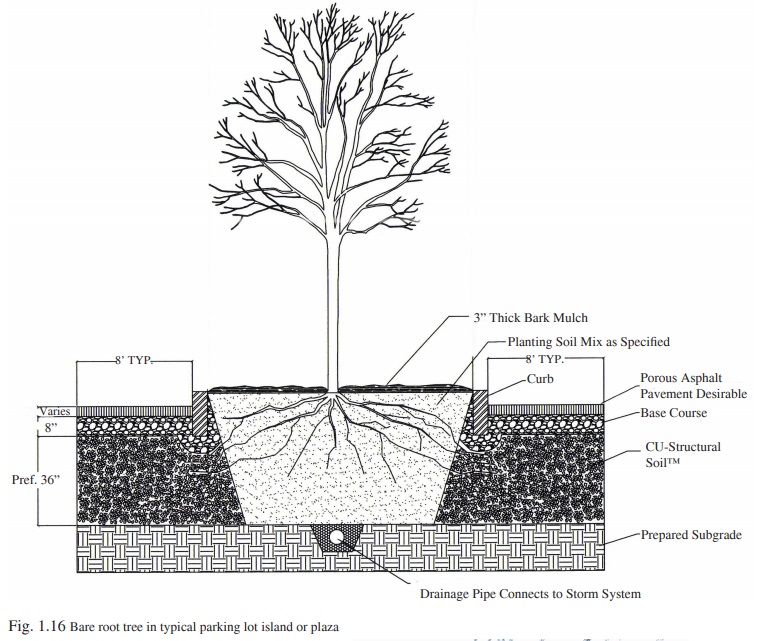
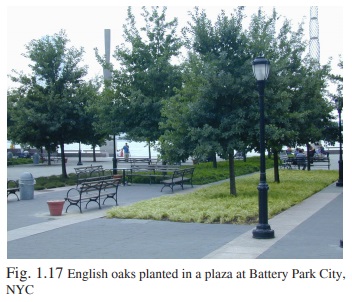
Positive drainage below the root system is
necessary in this system, since the sub-grade
below the CU-Structural Soil™ may be
compacted and impermeable. A perforated
and wrapped drain, connected to storm
drainage, should be placed between the CUStructural Soil™ and the compacted subgrade (Fig.1.18).
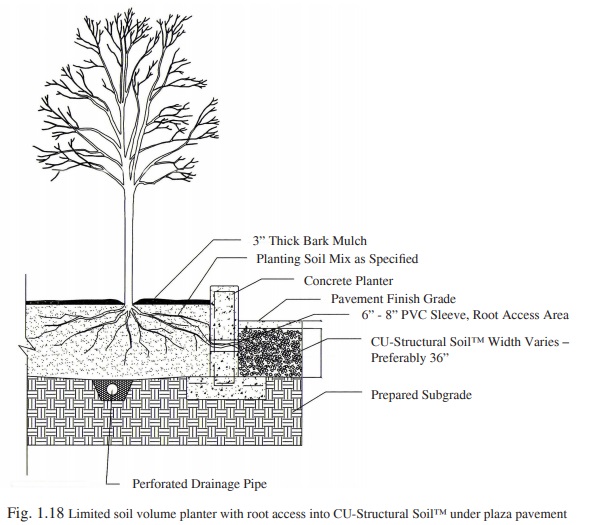
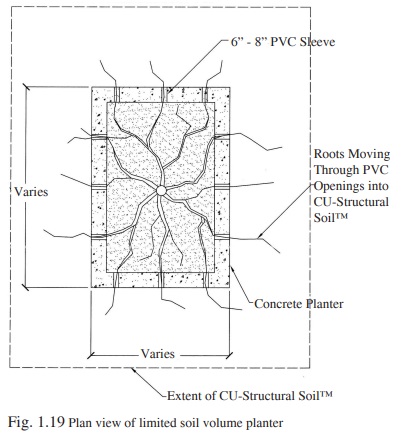
Where the curb footer goes to greater depth for a planter, a 6”- 8” PVC sleeve filled with uncompacted soil should be used to give tree roots access to the CU-Structural Soil™ beyond the planter wall (Figs 1.18-1.19).
Creating break-out zones for trees in narrow tree lawns
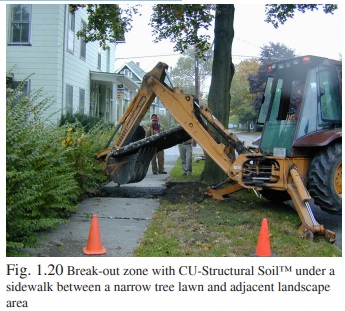 Where there is an adjacent green space, whether a park or front lawn, CU-Structural Soil™ may be used as a channel for roots to safely grow under pavement into this green space (Figs. 1.20 – 1.23). Generally two 5’ concrete flags are removed, then the area is excavated to 24”- 36” and CU-Structural Soil™ is backfilled into them. Paving slabs are then replaced in a conventional manner.
Where there is an adjacent green space, whether a park or front lawn, CU-Structural Soil™ may be used as a channel for roots to safely grow under pavement into this green space (Figs. 1.20 – 1.23). Generally two 5’ concrete flags are removed, then the area is excavated to 24”- 36” and CU-Structural Soil™ is backfilled into them. Paving slabs are then replaced in a conventional manner.
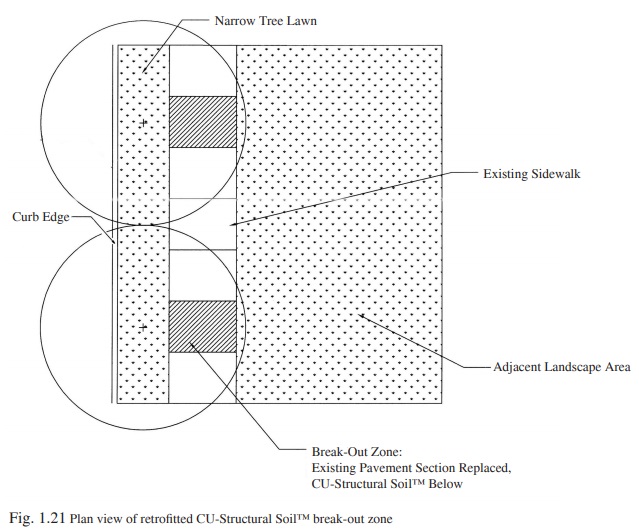
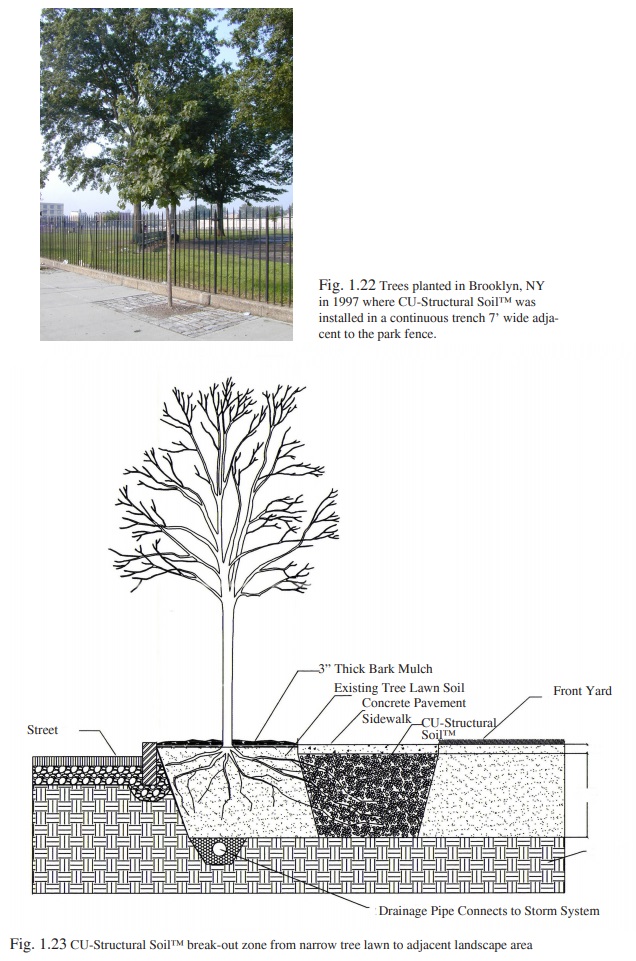
CU-Structural Soil ™ use with permeable pavers
If non-mortared pavers are used, a setting bed of uniformly-graded coarse sand should be used, to a depth specified by paver manufacturer specifications. To discourage rooting in this layer, a geo-textile—one that does not restrict water movement—can be used between this material and the CU-Structural Soil™ (Figs. 1.24 – 1.25).
